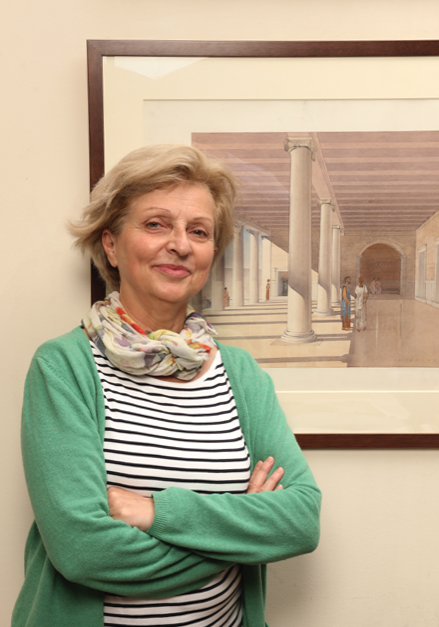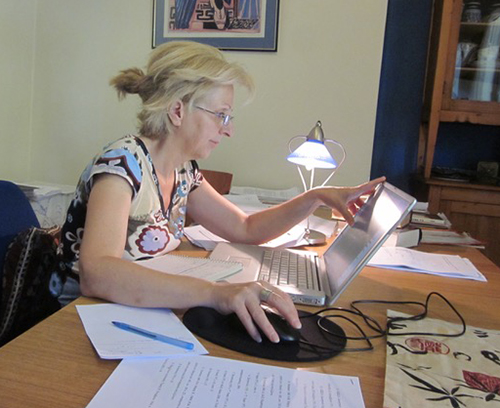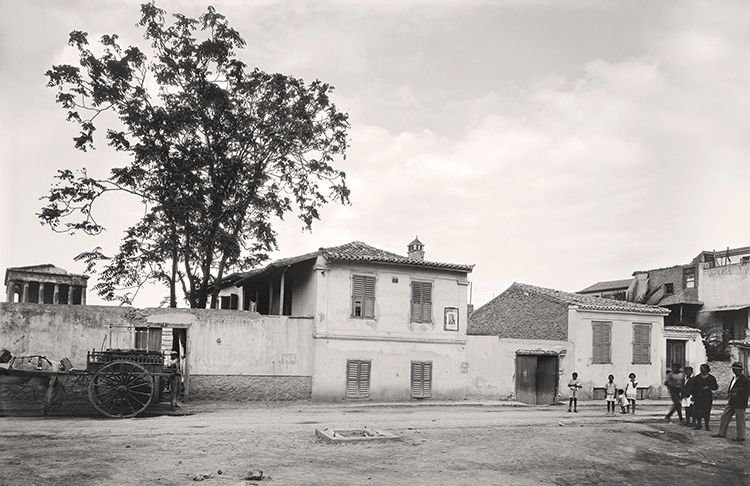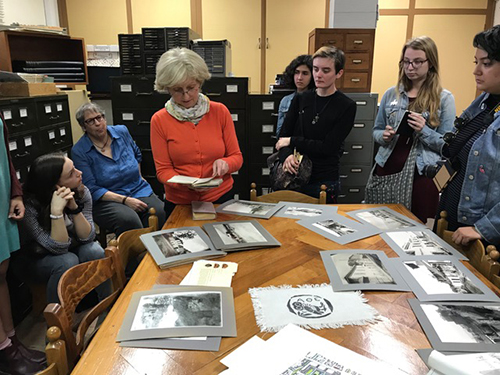
Bringing the Archives to Life: Reflections from Author Sylvie Dumont
Between 1931 and 1939, the ASCSA expropriated properties in the neighborhood at the foot of the Acropolis to begin excavations that would uncover the Athenian Agora. In her new publication, Vrysaki: A Neighborhood Lost in Search of the Athenian Agora, Sylvie Dumont provides readers with a portal to the past, using archival images and documents to help recreate the now-lost neighborhood: Vrysaki’s streets, shops, houses, faces, and names.
You moved to Greece in 1985. What brought you there, and how did you end up at the American School? Have you always had an interest in Greek archaeology?
I studied classical archaeology at Laval University (Québec City), and I had been to Greece twice before moving here. The first time I came as a student and visited as many archaeological sites as I could. The second time, I stayed for 8 months, learning the culture and the language. When I returned to Canada, I met my husband, who was living in Montreal at the time. We moved to Greece in 1985, so by coming back to Greece I was fulfilling two passions at once.
While living in Greece, I contacted the archaeological institutes to see if I could find a job in my field. I was offered a drafting position with the University of British Columbia on the island of Lesbos, and I worked there for four summers. Richard Anderson was the architect of the team. When William Dinsmoor Jr., architect of the Athenian Agora, died in 1988, Richard took his position at the Agora in 1989. Later on, he heard that they needed a part time assistant in the Agora Archives. I had just given birth to my first son and was looking for a job in Athens. I had an interview with John Camp and began work in December 1991. I was living in Thissio, only a 5-minute walk away, so everything was perfect!

Sylvie Dumont, Secretary and Registrar of the Agora Excavations in Athens
How did you first become interested in Vrysaki? What prompted you to begin this project nearly a decade ago?
During my first weeks in the Stoa, I saw the wonderful collection of photographs of the houses that connected me to a book I was reading at the time: Yiannis Simonetis’s Thissio (Θησείο). As a young boy, Simonetis lived in what he recalled as the Thissio neighborhood, but what was in fact part of Vrysaki. He wrote about daily life in the 1930s, and his descriptions and drawings fit so well with the photographs in our archives. It was a miracle; it all came to life!
While I was working in the archives, people sometimes stopped by to ask about their families who had lived in Vrysaki, but the only information they had was a street name or a vague location near a church or ruins. I realized that in the notebooks this information was scattered everywhere, and a single street could cover up to twelve sections. Because I was already interested in the collection, I thought it would be useful to organize the photos by street and cadastral number. By creating a kind of catalogue, I could help visitors to find their houses.
In addition, visitors wanted to know how the owners had been compensated and where they went after their homes were demolished. Scholars asked if there had been houses in Section OE before the 19th-century excavations in that section, or where the location of a specific house had been when a sculpture or an inscription was found in its wall. The idea of a more substantial book that could answer these kinds of questions came later.

Sylvie working on Vrysaki in 2014
Tell us a little bit about your process for researching this book. Where did you start?
My first step was to organize the photographs and to make a digital map. Everything was analog, and, apart from the large glass plates, the Leica photos pasted in the notebooks were too small to see details. It was only in 2004 when we could digitize the photos that I had the opportunity to bring copies home with me and begin working on the project in my free time.
At first, I imagined that it would be more of a photo album, but after visiting the ASCSA Archives, I realized that there was so much more information available. It was exciting to discover that Anastasios Adossides wrote his correspondence in French; it gave me the opportunity to enrich the book even more. When Emmanouil Tasoulas donated the notes of his aunt, Euyenia Yiannopoulou-Zographou, who worked in the Expropriation Department of the Ministry of Culture, it was reassurance that original contracts and deeds from the houses had been saved. With every step, I was adding more and more material, and the book began to take shape.
Tell us about a specific, memorable discovery you made during your research.
It was shocking to learn about the living conditions in Vrysaki. Often an entire family lived in one room.
What was the biggest challenge you faced while writing the book?
Creating a clear narrative from inconsistencies and discrepancies in the archival material, and also reading Greek laws in katharevousa.
Did you have the opportunity to speak with anyone who either lived in Vrysaki as a child, or whose parents/family lived in Vrysaki?
Because it had been already 60 years since the beginning of the excavations when I began working at the Stoa in 1991, only a few people managed to reach us. I remember in particular that two brothers of the Douros family came to see us in 2010. They remembered that their house had been at 16 Eponymon Street when they were young. Unfortunately, it was one of the houses situated behind a courtyard wall (see Fig. 122 in Vrysaki), so the photograph I found of that address did not show their house. According to the [street] name and vantage point of the photograph, it was the right property on the right street, but when the older brother, Ioannis, examined the photograph, he could not be certain. His younger brother, Sokratis, however, pulled me aside and told me that he remembered when it rained, his grandfather would ask him to help him place a plank between the entrance gate and the house. There was no drainage system at the time, and water would accumulate near the entrance to their house. The plank helped visitors stay dry when entering the house from the street. Sokratis said, “Do you see that stain on the bottom of the wall and wooden double doors. I remember that stain, and I am sure this is the house!”

View of Eponymon Street from the Square of the Stoa of the Giants. The main entrance to the house of the Douros family is marked by the wooden double doors near the children standing in the street. The water stains Sokratis remembered are clearly visible on the bottom of these double doors.
Another time, more recently, nuns from the monastery of Ayias Triados in Koropi, were hoping to find the house of their Mother Superior, Zoe Chronopoulou, who had lived in Vrysaki somewhere near the Church of Panayia Vlassarou on Ptolemaiou Street. That was the only hint we had and the fact that the cantor of the church, named Pappas, was a tenant in the same house. Based on this information, I located the address of the house and found a photograph, although not a very clear one. They were very moved, and since then continue to send homemade cookies and small icons to the Agora.
What do you hope readers will take away from reading your book?
I wanted to reach the families of owners and tenants, and explain how excavations in this area were actually supposed to happen since 1833. I wanted to give a complete view of the story. In addition, many younger Athenians do not know that this neighborhood existed. I also wanted to provide a coherent presentation of archival material from the School and the Ministry of Culture because there is still so much more work to be done.

Sylvie sharing photos of Vrysaki with students visiting from Bryn Mawr College
Do you have any new projects on the horizon?
My next step is to complete my database with all the tenant names and connect every house with photographic material we have in the archives. Many more photos will be available on ascsa.net, and hopefully the database and map as well. Eventually I would like there to be interactivity between the database and map. If I was younger, I would try to do the same with the Roman Agora, so I hope some young scholar will take this project on!